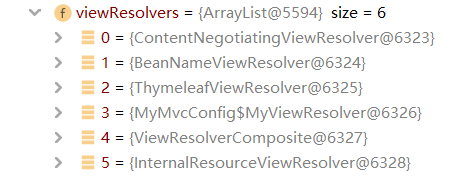SpringBoot MVC配置
SpringBoot MVC配置
在使用 SpringBoot 进行实际的项目开发前,最后再了解一下 SpringBoot 中对于 MVC 的配置!仍对应 SpringBoot-03-Web 项目。
1. MVC配置简介
SpringBoot 对 MVC 进行了许多的配置,查看官方文档可以看到其中的介绍
Spring MVC Auto-configuration
// Spring Boot 为 Spring MVC 提供了自动配置,它可以很好地与大多数应用程序一起工作。
Spring Boot provides auto-configuration for Spring MVC that works well with most applications.
// 自动配置在 Spring 默认设置的基础上添加了以下功能:
The auto-configuration adds the following features on top of Spring’s defaults:
// 包含了视图解析器
Inclusion of ContentNegotiatingViewResolver and BeanNameViewResolver beans.
// 支持静态资源文件夹的路径和 WebJars
Support for serving static resources, including support for WebJars
// 自动注册了 Converter(转换器),作用是将网页提交到后台的数据封装为对象
// 如提交字符串"1" 就会转换为 int 类型的 1
// Formatte(格式化器),可以将如2021-9-1格式的数据格式化为 Date 对象
Automatic registration of Converter, GenericConverter, and Formatter beans.
// 提供了 HttpMessageConverters支持
// 它是 SpringMVC 用来转换 Http 请求和响应的的,如将一个User对象转换为JSON字符串(详细的请查看文档)
Support for HttpMessageConverters (covered later in this document).
// 定义错误代码生成规则的
Automatic registration of MessageCodesResolver (covered later in this document).
// 首页定制
Static index.html support.
// 图标定制
Custom Favicon support (covered later in this document).
// 初始化数据绑定器:把请求数据绑定到 JavaBean 中!
Automatic use of a ConfigurableWebBindingInitializer bean (covered later in this document).
接下来就分析一下其中的几个配置!
2. 视图解析器
2.1 配置
SpringBoot 对 MVC 中的视图解析器进行了自动配置,首先查看 Web 的自动配置类 WebMvcAutoConfiguration,在其中可以看到视图解析器的构造方法
@ConditionalOnBean(ViewResolver.class)
@ConditionalOnMissingBean(name = "viewResolver", value = ContentNegotiatingViewResolver.class)
public ContentNegotiatingViewResolver viewResolver(BeanFactory beanFactory) {ContentNegotiatingViewResolver resolver = new ContentNegotiatingViewResolver();...return resolver;
}
它创建了一个 ContentNegotiatingViewResolver 类型的视图解析器,点进这个类,首先可以看到它实现了 ViewResolver 接口,所以它就是一个视图解析器!
public class ContentNegotiatingViewResolver extends WebApplicationObjectSupportimplements ViewResolver, Ordered, InitializingBean
再找到它关于视图解析的部分,是一个方法 resolveViewName,返回了一个视图
@Nullable
public View resolveViewName(String viewName, Locale locale) throws Exception {RequestAttributes attrs = RequestContextHolder.getRequestAttributes();Assert.state(attrs instanceof ServletRequestAttributes, "No current ServletRequestAttributes");List<MediaType> requestedMediaTypes = this.getMediaTypes(((ServletRequestAttributes)attrs).getRequest());if (requestedMediaTypes != null) {List<View> candidateViews = this.getCandidateViews(viewName, locale, requestedMediaTypes);View bestView = this.getBestView(candidateViews, requestedMediaTypes, attrs);if (bestView != null) {return bestView;}}String mediaTypeInfo = this.logger.isDebugEnabled() && requestedMediaTypes != null ? " given " + requestedMediaTypes.toString() : "";if (this.useNotAcceptableStatusCode) {if (this.logger.isDebugEnabled()) {this.logger.debug("Using 406 NOT_ACCEPTABLE" + mediaTypeInfo);}return NOT_ACCEPTABLE_VIEW;} else {this.logger.debug("View remains unresolved" + mediaTypeInfo);return null;}
}
其中有两句关键的代码
// 获取所有候选视图
List<View> candidateViews = this.getCandidateViews(viewName, locale, requestedMediaTypes);
// 选择最好的视图(何谓最好?)
View bestView = this.getBestView(candidateViews, requestedMediaTypes, attrs);
查看获取所有候选视图方法 getCandidateViews,可以看到它遍历了所有的视图解析器,向候选视图列表中添加视图
List<View> candidateViews = new ArrayList<>();
...
for (ViewResolver viewResolver : this.viewResolvers) {View view = viewResolver.resolveViewName(viewName, locale);if (view != null) {candidateViews.add(view);}for (MediaType requestedMediaType : requestedMediaTypes) {List<String> extensions = this.contentNegotiationManager.resolveFileExtensions(requestedMediaType);for (String extension : extensions) {String viewNameWithExtension = viewName + '.' + extension;view = viewResolver.resolveViewName(viewNameWithExtension, locale);if (view != null) {candidateViews.add(view);}}}
}
这就是 SpringBoot 默认的关于视图解析器的配置!
2.2 自定义
此时我们先尝试自定义一个视图解析器,在 com.qiyuan 包下创建 config 包,并在其中创建 MyMvcConfig 类,添加 @Configuration 注解并实现 WebMvcConfigurer 接口,表明它是 WebMvc 的配置类
@Configuration
public class MyMvcConfig implements WebMvcConfigurer {}
在其中创建一个静态内部类 MyViewResolver,实现 ViewResolver 接口,即是一个视图解析器;再使用 @Bean 将它作为组件放入容器中
@Configuration
public class MyMvcConfig implements WebMvcConfigurer {@Beanpublic ViewResolver myViewResolver(){return new MyViewResolver();}// 自定义的视图解析器public static class MyViewResolver implements ViewResolver{@Overridepublic View resolveViewName(String viewName, Locale locale) throws Exception {return null;}}
}
这样我们自定义的视图解析器就放入 Spring 中了,运行的时候就会被检测到!
2.3 测试
查看完 SpringBoot 的视图解析器配置,并且有自定义了一个视图解析器的配置后,就可以来测试一下了。
首先在 SpringMVC 中我们知道,任何请求都要经过 DispatcherServlet,全局搜索这个类,并找到其中的核心方法 doDispatcher
protected void doDispatch(HttpServletRequest request, HttpServletResponse response) throws Exception
具体内容是什么不用关心,先在这个方法上打上断点,然后开始程序调试。访问 localhost:8080,程序进入了断点。此时查看 DispatcherServlet 类中的变量,可以看到 viewResolver

这里就出现了四个见过的面孔!ContentNegotiatingViewResolver 和 BeanNameViewResolver 是 SpringBoot 中的 MVC 配置包含的,ThymeleafViewResolver 则是上节导入 Thymeleaf 而产生的,最后是 MyMvcConfig 中的( $ 符号应该是表示类中的对象)MyViewResolver ,我们自定义的视图解析器!
2.4 小结
从上面的测试中我们就可以知道,SpringBoot 中有默认的配置,它们会被自动装配为组件(如上面的0和 1);如果我们引入了别的配置,它也会被装配为一个组件(如上面的2,Thymeleaf );如果我们想自定义地为 SpringBoot 添加组件,只要写好对应的配置类,将这个组件放到 Spring 容器中,它也会自动地被装配(如上面的3,MyViewResolver )!
简而言之,如果我们想要进行一些功能的定制,只要给 Spring 容器添加这个功能的组件就行了!
3. 扩展MVC功能
现在来尝试扩展 MVC 的功能,在官方文档中,还有这么一段话
/*
如果您希望保留Spring Boot MVC功能,并且希望添加其他MVC配置(拦截器、格式化程序、视图控制器和其他功能),
则可以添加自己的@configuration类,类型为webmvcconfigurer,但不添加@EnableWebMvc。
如果希望提供RequestMappingHandlerMapping、RequestMappingHandlerAdapter或ExceptionHandlerExceptionResolver的自定义实例,
则可以声明WebMVCregistrationAdapter实例来提供此类组件。
*/
If you want to keep Spring Boot MVC features and you want to add additional MVC configuration
(interceptors, formatters, view controllers, and other features), you can add your own
@Configuration class of type WebMvcConfigurer but without @EnableWebMvc. If you wish to provide
custom instances of RequestMappingHandlerMapping, RequestMappingHandlerAdapter, or
ExceptionHandlerExceptionResolver, you can declare a WebMvcRegistrationsAdapter instance to provide such components.
即如果需要添加功能,即创建一个 WebMvcConfigurer 类并加上 @Configuration 注解,也就是上面创建视图解析器的过程,当然也可以创建拦截器、视图控制器等组件。
现在尝试创建一个视图控制器,在 MyMvcConfig 类中重写 addViewControllers 方法
@Configuration
public class MyMvcConfig implements WebMvcConfigurer {...@Overridepublic void addViewControllers(ViewControllerRegistry registry) {// 将 /test 请求定向到 hello 视图registry.addViewController("/test").setViewName("hello");}}
这样就为我们的 MVC 配置添加了一个视图控制器,运行程序 ,访问 localhost:8080/test,成功进入之前的 hello.html 页面,当然因为没有设置模型,所以没有内容。
为什么我们写的配置类也会被加载呢?下面分析一下原理!
-
首先,Web 的自动配置需要
WebMvcAutoConfiguration组件,它里面有一个内部类WebMvcAutoConfigurationAdapter,即配置适配器类@Configuration(proxyBeanMethods = false) @Import(EnableWebMvcConfiguration.class) ... @Order(0) public static class WebMvcAutoConfigurationAdapter implements WebMvcConfigurer, ServletContextAware -
这个配置适配器类通过注解
@Import(EnableWebMvcConfiguration.class)又导入了一个类,即开启配置类@Configuration(proxyBeanMethods = false) @EnableConfigurationProperties(WebProperties.class) public static class EnableWebMvcConfiguration extends DelegatingWebMvcConfiguration implements ResourceLoaderAware -
这个开启配置类继承了一个父类
DelegatingWebMvcConfiguration,即删除配置类(?),它的开头就有这么一段代码@Configuration(proxyBeanMethods = false) public class DelegatingWebMvcConfiguration extends WebMvcConfigurationSupport {private final WebMvcConfigurerComposite configurers = new WebMvcConfigurerComposite();// 从容器中获取所有 WebMvcConfigurer@Autowired(required = false)public void setConfigurers(List<WebMvcConfigurer> configurers) {if (!CollectionUtils.isEmpty(configurers)) {this.configurers.addWebMvcConfigurers(configurers);}}... }可以看到它获取并设置了所有的
WebMvcConfigurer配置类! -
以
DelegatingWebMvcConfiguration类中的addViewControllers方法为例(之前的例子就是添加了一个视图控制器)@Override protected void addViewControllers(ViewControllerRegistry registry) {this.configurers.addViewControllers(registry); } -
继续查看它调用的
addViewControllers方法,跳转到了WebMvcConfigurerComposite类中的addViewControllers方法,这个类就是 3 中的configurers的类型!private final List<WebMvcConfigurer> delegates = new ArrayList<>(); ... @Override public void addViewControllers(ViewControllerRegistry registry) {for (WebMvcConfigurer delegate : this.delegates) {// 调用了所有的 WebMvcConfigurer 配置,包括 Spring 自带的和我们自己配置的!delegate.addViewControllers(registry);} }这里就可以看到,所有的
WebMvcConfigurer都会被调用加载,包括 SpringBoot 自带的和我们自己配置的!(这里有点乱,但先这样吧)
4. 全面接管MVC
在官方文档中还有一小段不起眼的话
// 如果您想完全控制Spring MVC,可以添加自己的@Configuration,并用@EnableWebMvc进行注释。
If you want to take complete control of Spring MVC, you can add your own @Configuration annotated with @EnableWebMvc.
意思就是,只要在自定义的配置类( @Configuration )上添加了 @EnableWebMvc,就可以由我们全面接管 SpringMVC!
如在 MyMvcConfig 类上加上 @EnableWebMvc 注解
@Configuration
@EnableWebMvc
public class MyMvcConfig implements WebMvcConfigurer {...
}
此时再运行程序,访问 localhost:8080(注意不是 /test 也不是 /hello,因为之前自定义了配置,所以这两个是能请求到的),就会产生 404 错误,因为默认的配置已经被屏蔽掉了!
为什么加了一个 @EnableWebMvc 注解自动配置就失效了呢?再分析一下原理!
-
点进
@EnableWebMvc注解,可以看到它导入了删除配置类DelegatingWebMvcConfiguration的组件,这个类在上面也见过了!@Import(DelegatingWebMvcConfiguration.class) public @interface EnableWebMvc { } -
点进
DelegatingWebMvcConfiguration类,可以看到它也继承了一个父类WebMvcConfigurationSupport@Configuration(proxyBeanMethods = false) public class DelegatingWebMvcConfiguration extends WebMvcConfigurationSupport -
这时回到最开始的配置类
WebMvcAutoConfiguration上,可以看到生效场景的注解@ConditionalOnMissingBean(WebMvcConfigurationSupport.class)@ConditionalOnMissingBean(WebMvcConfigurationSupport.class) ... public class WebMvcAutoConfiguration说明这个自动配置类只有在没有导入
WebMvcConfigurationSupport类的场景下才会被自动装配!而使用@EnableWebMvc注解正是导入了这个类,导致了自动配置类的失效,回到了最原始的状态!
总而言之,@EnableWebMvc 引入了 WebMvcConfigurationSupport 类,而这个类只有 SpringMVC 最基本的支持!
5. 总结
这节又深入了解了 SpringBoot 中 MVC 的一些配置,以及如何去扩展 MVC 的配置,如拦截器、视图解析器、视图控制器等,这就是编写实际项目前的最后一块拼图😤!
本文来自互联网用户投稿,文章观点仅代表作者本人,不代表本站立场,不承担相关法律责任。如若转载,请注明出处。 如若内容造成侵权/违法违规/事实不符,请点击【内容举报】进行投诉反馈!